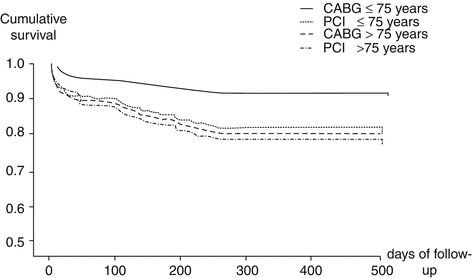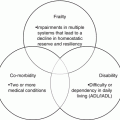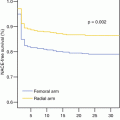Study
Angina
Exercise time
Number of medications
Early
Late
Early
Late
Early
Late
ACME
64 % vs. 46 %* free of angina at 6 months
62 % vs. 47 %* free of angina at 3 years
11.2 min vs. 9.5* min exercise time duration at 6 months
10.0 min vs. 8.5* min exercise time duration at 3 years
30 % vs. 50 % on ß-blocker*, 35 % vs. 71 % on CCB*, and 24 % vs. 50 % on nitrate* at 6 months
28 % vs. 39 % on ß-blocker, 47 % vs. 72 % on CCB*, and 24 % vs. 52 % on nitrate* at 3 years
RITA-2
19.4 % vs. 35.9 %* at 3 months
15.0 % vs. 21.4 %* at 5 years
37 s in favor of PCI* at 3 months
25 s in favor of PCI* at 3 years
37 % vs. 57 % on ≥2 drugs at 3 months
31 % vs. 45 % on ≥2 drugs at 5 years
AVERT
Improvement in angina 54 % vs. 41 %* at 1.5 years
–
–
–
61 % vs. 60 % on ß-blocker, 44 % vs. 49 % on CCB, and 50 % vs. 60 % on nitrate at 1.5 years
–
TIME
Significant improvement in angina class at 6 months
No differences in angina class at 1 year
–
–
Significant reduction of number of drugs at 6 months
Significant reduction of number of drugs at 1 year
MASS II
21 % (PCI) vs. 12 % (CABG) vs. 54 % (MT) free of angina* at 1 year
41 % (PCI) vs. 36 % (CABG) vs. 57 % (MT) free of angina* at 10 years
–
–
–
–
SWISSI II
–
–
Max workload at bicycle ergometry 169 W vs. I48 W* at 4 years
Max workload at bicycle ergometry I73 W vs. 136 W* at 10 years
49 % vs. 86 % on ß-blocker*,21 % vs. 51 % on CCB*, and 12 % vs. 47 % on nitrate* at 4 years
39 % vs. 84 % on ß-blocker*, 17 % vs. 32 % on CCB, and 4 % vs. 45 % on nitrate* at 10 years
COURAGE
56 % vs. 47 %* free of angina at 6 months
59 % vs. 56 % free of angina at 3 years
–
–
85 % vs. 89 % on ß-blocker, 40 % vs. 49 % on CCB*, and 53 % vs. 67 % on nitrate* at 1 year
85 % vs. 86 % on ß-blocker, 42 % vs. 52 % on CCB*, and 40 % vs. 57 % on nitrate* at 5 years
Differences to a Younger Patient Cohort
According to recent ESC guidelines for myocardial revascularization in younger patient cohorts, angina is associated with the following: reduced exercise capacity, reduced quality of life, mental depression and repeated hospitalizations [5]. This is where the disparity to an elderly population becomes apparent. Elderly patients will probably not experience ischemia as angina, which will become noticeable as a decline in exercise capacity, congestive heart failure, dyspnea or, in some cases even as confusion or delirium. Albeit the incidence of CAD is growing with advanced age, with autopsy studies suggesting a prevalence of at least 70 % in patients >70 years, however only 15–30 % of the patients over 65 years show clinical signs of CAD. The discrepancy between clinical and autopsy prevalence implicates, that CAD often is silent and goes undetected in this patient group. This is underlined by a significantly reduced angina detection in elderly patients. Rittger et al. showed in a study of 101 patients undergoing PCI, in repeated balloon inflations during PCI, a significantly reduced pain sensitivity in patients >69 years compared with a younger patient group [6]. Another study by Ambepitiya et al. [7], investigated age-associated changes in pain perception, by comparing the time delay between the onset of ST-segment depression and the onset of AP during exercise stress testing. The authors found a significant difference of the mean delay to onset of pain, which was 49 s in patients aged 70–82 years and 30s in patients aged 42–59 years. One can conclude from these results, that there is an age dependent reduction in pain sensitivity, independent of objective signs of ischemia and of ischemic preconditioning. The reasons for the diminished pain perception in the elderly patient cohort remain unclear. Ambepitiya et al. postulated that peripheral mechanisms such as changes in the myocardial autonomic nerve endings with blunted ischemic pain perception, as well as changes in central nervous mechanisms, may be a cause for this phenomenon. Another theory suggested, that the higher prevalence of silent myocardial ischemia and infarction in elderly patients with CAD may be related to increased levels of endogenous opioids and increased opioid receptor sensitivity [8]. This explanation does not appear likely, as studies have demonstrated a similar increase in response of beta-endorphin levels to exercise in both elderly and younger patients [9]. Additionally, animal studies show a decrease in opioid receptor responsiveness with advancing age [10].
Moreover, with advanced age, it will become more difficult to perform ischemia testing in suspected CAD, since many elderly patients will not be able to carry out exercise tests due to physical disabilities (e.g. degenerative joint disease). Consequently, the detection of CAD in elderly patients prior to any diagnostic or therapeutic intervention, appears to be difficult in light of other age specific changes.
Results for PCI in Multivessel Disease
The success of CABG-surgery in earlier days has been attributed to the greater efficacy of surgery to achieve a complete revascularization in the setting of multivessel- and left main disease. Nevertheless, in the growing elderly population there are plenty of reasons to justify the search for alternatives to surgery. Many of these patients will have a higher risk for perioperative complications: for instance myocardial infarction, prolonged mechanical ventilation, pneumonia and especially neurological events. For a high percentage, the indication to perform CABG procedure with an even higher postoperative morbidity rate, seems at least to be questionable. Especially in view of the presumably preferred outcomes in the elderly, (since there is no data available about patients anticipations to revascularization) – namely to maintain their functional status and quality of life. The search for alternatives to CABG therefore has partially liberated the evolution of interventional cardiology.
There are plenty of trials evaluating the effectiveness of angioplasty in the treatment of multivessel disease, prior to the era of stenting and the introduction of DES in interventional cardiology. However, it is interesting to point out, that contrary to the present evidence in coronary bypass grafting, besides the TIME-trial (which compared the effect of coronary intervention with stenting in comparison to medical treatment alone), currently no randomized trial exists, which was exclusively performed in an elderly population. The majority of all trials were performed in an overall population, with subgroup analyses for elderly patients in some trials and the vast majority of the present evidence comes from retrospective analyses.
Starting with the balloon era in an overall population, the BARI-trial (Bypass Angioplasty Revascularization Investigation) as a milestone trial, showed an equivalent mortality rate after 30 days at the cost of a higher revascularization rate in patients receiving PCI (52 % vs. 6 % with CABG after 5 years) and a higher stroke rate in patients treated with CABG. However, it indicated a 5-year cardiac mortality in patients with multivessel disease, which was significantly greater after initial treatment with PTCA than with CABG. The difference was manifest in diabetic patients on drug therapy: there were no significant differences overall for the composite end point of cardiac mortality or MI between treatment groups or for cardiac mortality in nondiabetic patients, regardless of symptoms, left ventricular function, number of diseased vessels or stenotic proximal left anterior descending artery (Figs. 7.1 and 7.2) [11].



Fig. 7.1
Adjusted overall MACE rates at the end of follow-up, according to age and procedure (Adapted from Ref. [13] with permission)

Fig. 7.2
Thirty day mortality rates for CABG (panel a) and PCI (panel b) in different studies (Adapted from Ref. [21] with permission)
In the following decade, the implementation of stent techniques and the introduction of modern antiplatelet therapies has expanded the potential of interventional therapies substantially.
In the Alberta Provincial Project for outcomes Assessment in Coronary Heart Disease (APPROACH) study, a large cohort of patients >70 years undergoing PCI were studied and their survival examined by prescribed treatment (CABG, PCI, or medical therapy) for patients in three age categories: <70 years, 70–79 years, and ≥80 years of age. In 15 392 patients, 4-year adjusted actuarial survival rates for CABG, PCI and medical therapy were 95.0 %, 93.8 %, and 90.5 %, respectively. In 5198 patients 70–79 years of age, survival rates were 87.3 %, 83.9 %, and 79.1 %, respectively. In 983 patients ≥80 years of age, survival was 77.4 % for CABG, 71.6 % for PCI, and 60.3 % for medical therapy. Absolute risk differences in comparison to medical therapy for CABG (17.0 %) and PCI (11.3 %) were greater for patients ≥80 years of age than for younger patients. After 4 years, those patients over 80 years had the poorest survival rate with medical therapy 60.3 %, PCI 71.6 % and CABG 77.4 %. In this study, for the first time, the so-called risk-paradoxon was described: elderly patients paradoxically had greater absolute risk reductions, associated with surgical or percutaneous revascularization, than do younger patients. The combination of these results with a recent randomized trial suggests, that the benefits of aggressive revascularization therapies may extend to subsets of patients in older age groups [12].
Nonetheless, one has to keep in mind that due to a lack of randomized data, that probably the fittest were chosen to receive surgery and those patients in a worse condition were given medical therapy.
Comparing the outcome of older versus younger patients with CABG-procedure in a series of 300 patients with left main disease, Rittger et al. showed, that there was no difference in outcome and quality of life between older and younger patients treated with PCI [13].
In the ARTS-trial, which randomized 600 patients to PCI and 605 patients to CABG, patients treated with surgery showed longer symptom free survival [14]. Despite having more complex lesions, results from stenting were better than in the BARI trial. Interestingly, advanced age was an independent predictor of unfavorable outcome in the CABG-, but not in the PCI group.
All other trials from this era, like the ERACI-2 trial, demonstrated a favorable 18-month mortality rate in the PCI group, however a higher reintervention rate [15]. The SOS-trial showed the same results, namely higher reintervention rates and lower stroke rates with PCI. It is interesting to note, that after 1 year in the SOS trial, quality of life and physical health status was comparable between the two groups in the elderly subgroups [16]. The only study with a predominantly elderly population was the AWESOME-study (more than 50 % of the patients enrolled were >67 years), which randomized patients with a high risk profile for cardiac shock or reduced LV-EF [17]. Results showed a similar outcome after 3 years regarding longterm mortality and quality of life.
The most recent SYNTAX-trial randomized patients with either left main or three-vessel disease to CABG or PCI, contrary to previous trials where patients received drug evading stents [18]. After 3 years there was no significant difference in the composite endpoint death, MI and stroke, with a higher rate of revascularization in the PCI group. Moreover, in this study the SYNTAX-Score was introduced, as an anatomical and morphologic grading tool in order to encompass the complexity of coronary artery disease. It consists of different angiographic scoring systems for the evaluation of bifurcations, the extent of calcifications and the presence of chronic occlusions. With a cut-off value of 33, it differentiates patients who will likely benefit from an intervention and those who will not, nota bene patients throughout all age groups. This score does include angiographic items and is able to predict reintervention rates, however not clinical outcomes of patients with multivessel disease. Furthermore, it is very helpful in the decision making process concerning the usefulness of coronary intervention or transferring to bypass surgery.
Again it is noteworthy, that all these trials have not been performed in an exclusively elderly population, which underlines the need for a randomized study in the elderly population.
Results for CABG
As already mentioned, all studies comparing different treatment strategies in the elderly, patients treated with PCI have a favorable short term outcome, however longterm outcome appears to be in favor of surgery. Compared to a younger population, in-hospital mortality rates for patients operated with stable coronary artery disease are higher than in younger patients and results are reported to be in a range between 2.2 and 9.7 %. Nevertheless, with the evolution of surgical techniques (e.g. off-cap-technique or the frequent use of the internal mammary artery), a significant and continuing drop in complication rates has been documented.
In an early study, CABG procedure in elderly patients was associated with a mortality rate of 24 % [20] and in comparison to a recent meta-analysis of 65 studies juxtaposing CABG surgery with PCI, reported a 30 day mortality of 5.3 % [21]. Since several studies confirm the decline in mortality rates [19, 22, 23], one could conclude, that age is not a prognostic parameter any longer, nonetheless age is an incremental part of the two most predominantly used clinical scores, the STS and Euro-Score.
In a sequential cross sectional analysis in a single center retrospective study, examining 1062 consecutive patients 80 years and older with a mean age of 83 ± 2.8 years, Kurlansky and co found an in-hospital mortality of initially 9.7 %, which decreased to 2.2 % in the course of the study between 1989 and 2001. In-hospital complications were reported at a rate of 33 % ranging from complications such as reoperation due to bleeding (3.2 %), perioperative myocardial infarction in 1.5 %, low cardiac output in 16.2 %, cardiac arrest 7.8 %, renal insufficiency in 9.8 %, respiratory insufficiency in 17.8 %, cerebrovascular accident 3.2 % and deep sternal infection in 1.5 %. The following independent correlations of hospital mortality were identified: date of surgery, arrhythmia, abnormal ejection fraction, renal insufficiency, non-elective surgery conduit type and reperfusion time.
Using Medicare claims data (with 10,141 patients with ACS and aged 85 years or older), Sheridan et al. discovered after 3 years early benefits, with lesser morbidity and mortality with PCI, however CABG outcomes improved by 3 years [24




Stay updated, free articles. Join our Telegram channel

Full access? Get Clinical Tree







